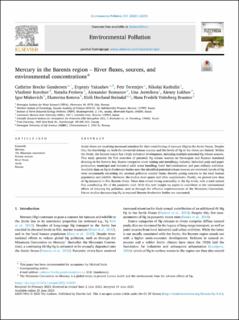| dc.contributor.author | Gundersen, Cathrine Brecke | |
| dc.contributor.author | Yakushev, Evgeniy | |
| dc.contributor.author | Terentjev, Petr | |
| dc.contributor.author | Kashulin, Nikolai | |
| dc.contributor.author | Korobov, Vladimir | |
| dc.contributor.author | Frolova, Natalia | |
| dc.contributor.author | Romanov, Alexander | |
| dc.contributor.author | Jermilova, Una | |
| dc.contributor.author | Lokhov, Alexey | |
| dc.contributor.author | Miskevich, Igor | |
| dc.contributor.author | Kotova, Ekaterina | |
| dc.contributor.author | Steindal, Eirik Hovland | |
| dc.contributor.author | Braaten, Hans Fredrik Veiteberg | |
| dc.date.accessioned | 2023-07-27T13:26:01Z | |
| dc.date.available | 2023-07-27T13:26:01Z | |
| dc.date.created | 2023-07-24T14:34:16Z | |
| dc.date.issued | 2023 | |
| dc.identifier.citation | Environmental Pollution. 2023, 333, 122055. | en_US |
| dc.identifier.issn | 1566-0745 | |
| dc.identifier.uri | https://hdl.handle.net/11250/3081650 | |
| dc.description.abstract | Arctic rivers are receiving increased attention for their contributing of mercury (Hg) to the Arctic Ocean. Despite this, the knowledge on both the terrestrial release sources and the levels of Hg in the rivers are limited. Within the Arctic, the Barents region has a high industrial development, including multiple potential Hg release sources. This study presents the first overview of potential Hg release sources on Norwegian and Russian mainland draining to the Barents Sea. Source categories cover mining and metallurgy industry; historical pulp and paper production; municipal and industrial solid waste handling; fossil fuel combustion; and past military activities. Available data on Hg in freshwater bodies near the identified potential release sources are reviewed. Levels of Hg were occasionally exceeding the national pollution control limits, thereby posing concern to the local human population and wildlife. However, the studies were sparse and often unsystematic. Finally, we present new data of Hg measured in five Barents rivers. These data reveal strong seasonality in the Hg levels, with a total annual flux constituting 2% of the panarctic total. With this new insight we aspire to contribute to the international efforts of reducing Hg pollution, such as through the effective implementation of the Minamata Convention. Future studies documenting Hg in exposed Barents freshwater bodies are warranted. | en_US |
| dc.language.iso | eng | en_US |
| dc.publisher | Elsevier | en_US |
| dc.rights | Navngivelse 4.0 Internasjonal | * |
| dc.rights.uri | http://creativecommons.org/licenses/by/4.0/deed.no | * |
| dc.title | Mercury in the Barents region – River fluxes, sources, and environmental concentrations | en_US |
| dc.type | Peer reviewed | en_US |
| dc.type | Journal article | en_US |
| dc.description.version | publishedVersion | en_US |
| dc.rights.holder | © 2023 The Authors | en_US |
| dc.source.pagenumber | 14 | en_US |
| dc.source.volume | 333 | en_US |
| dc.source.journal | Environmental Pollution | en_US |
| dc.identifier.doi | 10.1016/j.envpol.2023.122055 | |
| dc.identifier.cristin | 2163261 | |
| dc.source.articlenumber | 122055 | en_US |
| cristin.ispublished | true | |
| cristin.fulltext | original | |
| cristin.qualitycode | 1 | |

